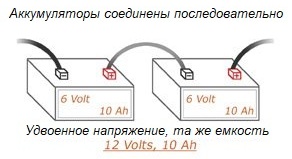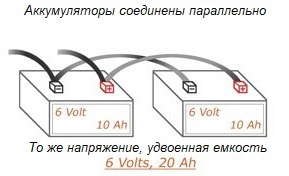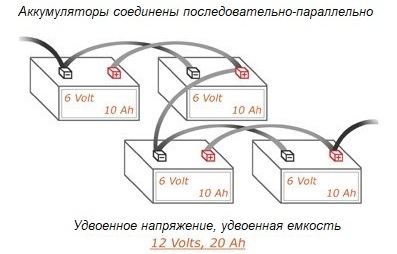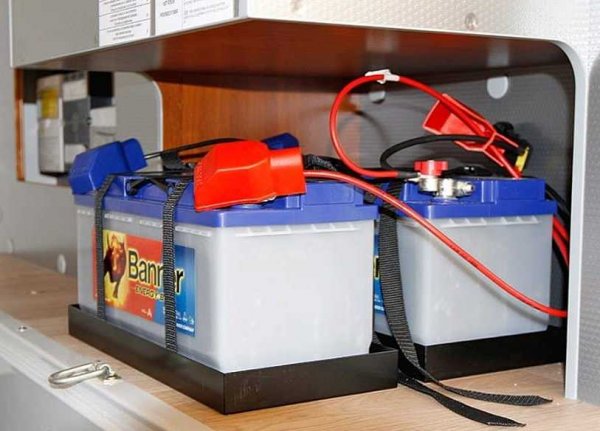Series, parallel and mixed connection of batteries
Everyone battery, depending on its type, has certain passport values: nominal voltage, maximum current, optimal current, nominal capacity. Note that these passport values are correct only if the manufacturer's recommended operating mode of the battery is observed and only for those batteries whose life resource is far from exhausted.
It also happens that it is necessary to immediately achieve more from the battery than what it is capable of according to the passport. Therefore, to increase the capacity, operating current or voltage, they often resort to series, parallel, and sometimes mixed (series-parallel) connection of batteries (cells, cells).
So, for lithium-ion and lithium-polymer batteries, the nominal voltage value for one cell will be 3.7 V, for lead-acid batteries - 2.1 V, for nickel-zinc - 1.6 V, and for nickel-cadmium and nickel metal hydride — 1.2 V.
As for the capacity and optimal current of the battery, these parameters depend on many design parameters: on the area of the electrodes, on the volume of the cell, on the density of the electrolyte, etc.
If it is necessary to obtain a higher operating voltage, then the battery cells are connected in series, if high capacity and current are needed, in parallel, if it is necessary to increase the capacity and increase the voltage, use series-parallel connection of batteries.
Series connection of batteries and its characteristics
From the very beginning, it is necessary to understand that for batteries connected in series - the current through each battery of such an assembly (battery) will always be equal to the current through the entire node and regardless of whether the battery is discharging at that moment or charging.
For this reason, it is strongly recommended to connect only batteries of the same type (or sets) of the same capacity (real!) in series.
Why are they the same type? Because the minimum (to which you can discharge) and maximum (to which you can charge) voltage for each cell must be the same.

Now let us deal with the question why it is necessary that the capacitances connected in series should also be the same.
If batteries of different capacities are connected in series, then during the discharge process the cell with the smallest capacity will discharge faster than the others and may reach the point that a deep discharge occurs in one of the cells forming the assembly, while the others cells can still be safely released.This will disrupt the operation of the entire battery of batteries, its voltage will drop, and the capacity simply cannot be adequately realized in the load.
And in the process of charging such an uneven node, the following will happen: the battery cell with the smallest capacity will already be charged to the required voltage, while the neighbors with a larger capacity will remain uncharged.
To prevent such an unpleasant development of events (it happens that some of the cells, even during proper operation, lose their initial capacity earlier than others), the charger (or assembly) is equipped with an equalizing charge-discharge controller , which protects cells from critical modes.
One way or another, before connecting the batteries in a series installation, measure the capacity of each with a special device that is known to everyone and is widely available on the market.
In ampere-hours (Ah) or milliampere-hours (mAh), the battery capacity resulting from connecting identical batteries in series will be equal to the capacity of a single cell making up a series battery.
The rated current, like the capacitance, will be equal to the rated current of a single cell. The rated voltage (in volts) and energy (in watt-hours) will be equal to the sum of the rated voltages and watt-hours, respectively, of all the cells that make up the battery.
Parallel connection of batteries and its characteristics
The parallel connection of batteries is used when the voltage must be left as it is, but at the same time increase the total capacity and, accordingly, the rated current of the installation.
Cells with the same nominal voltages can be connected in parallel, it is also highly desirable that they are of the same type (so that the effect of operating conditions on the capacity and on the current characteristics for all cells is approximately the same).
At the time of connection, it is also desirable to equalize the current voltages in order to reduce the equalizing currents that will inevitably occur when the pole terminals of the cells are closed in parallel.

The capacity of the resulting module in ampere-hours, its operating current, as well as the stored energy in watt-hours will be equal to the sum of them for each of the cells forming the assembly.
When connecting battery cells in parallel, it is also important to remember that the resulting self-discharge current of a parallel node will be higher than the sum of the self-discharge currents characteristic of each cell individually, since some of the cells in the set will discharge at -fast and more resistant to self-discharge, the cells will discharge not only through themselves, but also through their neighbors, all the time, as it were, charging them.
Series parallel or mixed connection of batteries
If you understood the rules and features of series connection of battery cells and understood the principle of summation of capacity and current in parallel connection, then it will not be difficult for you to connect the resulting series nodes in parallel or parallel nodes in series.
Theoretically, to reduce the self-discharge current, it seems better to connect in parallel several previously prepared, properly assembled series circuits of the same capacity without parallel closing of adjacent connections.However, in practice it is easier to connect multiple parallel nodes together.

As a result, the principle of assembly formation is as follows: if in a mixed connection the number of cells in series (in one circuit of batteries connected in series) exceeds the number of cells in parallel (that is, exceeds the number of circuits), then the circuits are combined in parallel.
If in a mixed connection the number of parallel elements exceeds the number of elements in the circuit, then the parallel nodes are connected in series after making sure that their capacity is equal.

